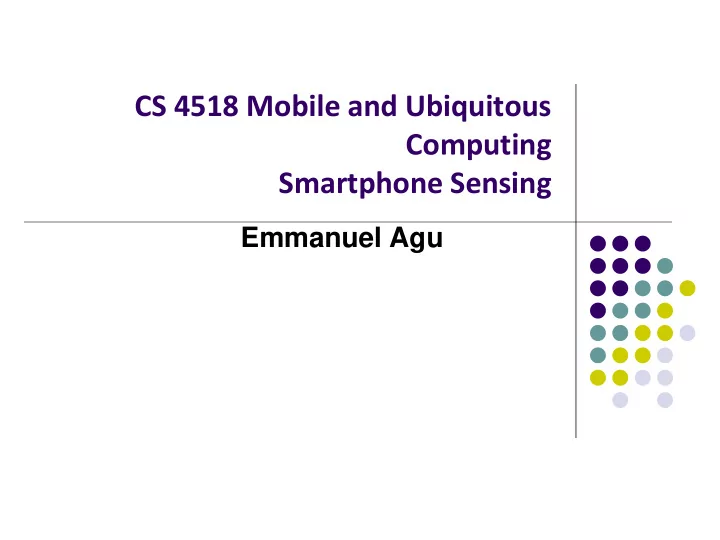

CS 4518 Mobile and Ubiquitous Computing Smartphone Sensing Emmanuel Agu
Smartphone Sensors Typical smartphone sensors today accelerometer, compass, GPS, microphone, camera, proximity Future sensors? • Heart rate monitor, • Activity sensor, • Pollution sensor, • etc
Mobile CrowdSensing Mobile CrowdSensing: Sense collectively Personal sensing: phenomena pertain to individual E.g: activity detection and logging for health monitoring Group: friends, co-workers, neighborhood GarbageWatch to improve recycling, neighborhood surveillance
Mobile CrowdSensing Community sensing (mobile crowdsensing): Large-scale phenomena monitoring Many people contribute their individual readings Examples: Traffic congestion, air pollution, spread of disease, migration pattern of birds, city noise maps
Mobile Crowd Sensing Types Many people cooperate, share sensed values 2 types: Participatory Sensing: User enters sensed values ( active involvement) 1. E.g. Comparative shopping: Compare price of toothpaste at CVS vs Walmart Opportunistic Sensing: Mobile device automatically senses values 2. ( passive involvement) E.g. Waze crowdsourced traffic
Sense What? Environmental: pollution, water levels in a creek Transportation: traffic conditions, road conditions, available parking City infrastructure: malfunctioning hydrants and traffic signs Social: photoblogging, share bike route quality, petrol price watch Health and well-being: Share exercise data (amount, frequency, schedule), share eating habits and pictures of food
Smartphone Sensing Examples
Personal Sensing Personal monitoring Focusing on user's daily life (Khan et al. 404)
Other Examples of Personal Participatory Sensing AndWellness “Personal data collection system” (Khan et al. 405) Active user-triggered experiences and surveys Passive recording using sensors UbiFit Garden “Uses smartphone sensors , real -time statistical modeling, and a personal, mobile display to encourage regular physical activity” (Khan et al. 406)
Personal Opportunistic Sensing PerFalld How It Works Detects if someone falls using sensor Starts a timer if it detects that someone fell If individual does not stop timer before it ends, emergency contacts are called (Khan et al. 416)
Public Sensing Data is shared with everyone for public good Traffic Environmental Noise levels Air pollution
Public Participatory Sensing LiveCompare User-created database of UPCs and prices GPS and cell tower info used to find nearby stores PetrolWatch Turns phone into fully automated dash-cam Uses GPS to know when gas station is near
Public Participatory Sensing Pothole Monitor Combines GPS and accelerometer Party Thermometer Asks you questions about parties Detects parties through GPS and microphone
Smartphone Sensing vs Dedicated Sensors
Sensing with Smartphones vs Dedicated Sensors More resources: Smartphones have much more processing and communication power Easy deployment: Millions of smartphones already owned by people Instead of installing sensors in road, we detect traffic congestion using smartphones carried by drivers Time-varying data: population of mobile devices, type of sensor data, accuracy changes often due to user mobility and differences between smartphones
Sensing with Smartphones vs Dedicated Sensors Reuse of few general-purpose sensors: While sensor • networks use dedicated sensors, smartphones reuse relatively few sensors for wide-range of applications E.g. Accelerometers used in transportation mode identification, – pothole detection, human activity pattern recognition, etc Human involvement: humans who carry smartphones can be • involved in data collection (e.g. taking pictures) Human in the loop can collect complex data – Incentives must be given to humans –
Smartphone Sensing Architecture
Smartphone Sensing Architecture Sense: Phones collect sensor data Learn: Information is extracted from sensor data by applying machine learning and data mining techniques Inform, share and persuasion: inform user of results, share with group/community or persuade them to change their behavior
Smartphone Sensing Architecture Sense: Phones collect sensor data Learn: Information is extracted from sensor data by applying machine learning and data mining techniques Inform, share and persuasion: inform user of results, share with group/community or persuade them to change their behavior Inform: Notify users of accidents (Waze) Share: Notify friends of fitness goals (MyFitnessPal) Persuasion: avoid speed traps (Waze)
References A Survey of Mobile Phone Sensing. Nicholas D. Lane, Emiliano Miluzzo, 1. Hong Lu, Daniel Peebles, Tanzeem Choudhury, Andrew T. Campbell, In IEEE Communications Magazine, September 2010 Mobile Phone Sensing Systems: A Survey, Khan, W.; Xiang, Y.; Aalsalem, 2. M.; Arshad, Q.; , Communications Surveys & Tutorials, IEEE , vol.PP, no.99, pp.1-26
Recommend
More recommend